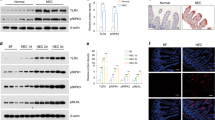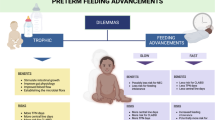Abstract
Background
The toll-like receptor 4 (TLR4) has been reported to play an important role in necrotizing enterocolitis (NEC). As an established regulator of TLR4, vitamin D has been demonstrated to be intestinal-protective. This study aims at finding out whether the vitamin D/vitamin D receptor (VDR) pathway ameliorates NEC by regulating TLR4.
Methods
Serum 25-hydrovitamin D (25(OH)D) was tested and compared in 15 preterm infants with NEC, 12 preterm infants without known complications and 20 healthy term infants. Neonatal Wistar rats were grouped and NEC was induced through formula feeding and cold/asphyxia stress. Vitamin D and the vehicle were administered to compare the microscopic structure, apoptotic protein expression, intestinal barrier function, inflammatory response, and TLR4 expression.
Results
Preterm infants with NEC had significantly lower 25(OH)D levels than those without NEC and healthy subjects. VDR expression was suppressed, whereas TLR4 expression was elevated in the NEC intestine. Vitamin D may increase the survival rate, alleviate structure damage, and preserve intestinal barrier function. These were achieved partly through restoration of VDR and suppression of TLR4.
Conclusion
NEC infants have lower levels of vitamin D. The vitamin D/VDR pathway protects against intestinal injury of NEC partly through suppressing the expression of TLR4.
Similar content being viewed by others
Log in or create a free account to read this content
Gain free access to this article, as well as selected content from this journal and more on nature.com
or
References
Lim JC, Golden JM, Ford HR . Pathogenesis of neonatal necrotizing enterocolitis. Pediatr Surg Int 2015;31:509–518.
Eaton S, Rees CM, Hall NJ . Current research on the epidemiology, pathogenesis, and management of necrotizing enterocolitis. Neonatology 2017;111:423–430.
Meng D, Zhu W, Shi HN et al. Toll-like receptor-4 in human and mouse colonic epithelium is developmentally regulated: a possible role in necrotizing enterocolitis. Pediatr Res 2015;77:416–424.
Hackam DJ, Good M, Sodhi CP . Mechanisms of gut barrier failure in the pathogenesis of necrotizing enterocolitis: Toll-like receptors throw the switch. Semin Pediatr Surg 2013;22:76–82.
Jilling T, Simon D, Lu J et al. The roles of bacteria and TLR4 in rat and murine models of necrotizing enterocolitis. J Immunol 2006;177:3273–3282.
Cetinkaya M, Erener-Ercan T, Kalayci-Oral T et al. Maternal/neonatal vitamin D deficiency: a new risk factor for necrotizing enterocolitis in preterm infants? J Perinatol 2017;37:673–678.
Zhu T, Liu TJ, Ge X, Kong J, Zhang LJ, Zhao Q . High prevalence of maternal vitamin D deficiency in preterm births in northeast China, Shenyang. Int J Clin Exp Pathol 2015;8:1459–1465.
Zhu T, Liu TJ, Shi YY, Zhao Q . Vitamin D/VDR signaling pathway ameliorates 2,4,6-trinitrobenzene sulfonic acid-induced colitis by inhibiting intestinal epithelial apoptosis. Int J Mol Med 2015;35:1213–1218.
Liu W, Chen Y, Golan MA et al. Intestinal epithelial vitamin D receptor signaling inhibits experimental colitis. J Clin Invest 2013;123:3983–3996.
Zheng W, Wong KE, Zhang Z et al. Inactivation of the vitamin D receptor in APCmin/+ mice reveals a critical role for the vitamin D receptor in intestinal tumor growth. Int J Cancer 2012;130:10–19.
Nadler EP, Dickinson E, Knisely A et al. Expression of inducible nitric oxide synthase and interleukin-12 in experimental necrotizing enterocolitis. J Surg Res 2000;92:71–77.
Soliman A, Michelsen KS, Karahashi H et al. Platelet-activating factor induces TLR4 expression in intestinal epithelial cells: implication for the pathogenesis of necrotizing enterocolitis. PLoS ONE 2010;5:e15044.
Caplan MS, Simon D, Jilling T . The role of PAF, TLR, and the inflammatory response in neonatal necrotizing enterocolitis. Semin Pediatr Surg 2005;14:145–151.
Sodhi CP, Shi XH, Richardson WM et al. Toll-like receptor-4 inhibits enterocyte proliferation via impaired beta-catenin signaling in necrotizing enterocolitis. Gastroenterology 2010;138:185–196.
Verma R, Jung JH, Kim JY . 1,25-Dihydroxyvitamin D3 up-regulates TLR10 while down-regulating TLR2, 4, and 5 in humanmonocyte THP-1. J Steroid Biochem Mol Biol 2014;141:1–6.
Gambhir V, Kim J, Siddiqui S et al. Influence of 1,25-dihydroxy vitamin D3 on TLR4-induced activation of antigen presenting cells is dependent on the order of receptor engagement. Immunobiology 2011;216:988–996.
Lee JW, Kim SC, Ko YS et al. Renoprotective effect of paricalcitol via a modulation of the TLR4-NF-κB pathway in ischemia/reperfusion-induced acute kidney injury. Biochem Biophys Res Commun 2014;444:121–127.
Jeong MS, Kim JY, Lee HI, Seo SJ . Calcitriol may down-regulate mRNA over-expression of toll-like receptor-2 and -4, LL-37 and proinflammatory cytokines in cultured human keratinocytes. Ann Dermatol 2014;26:296–302.
Jilling T, Lu J, Jackson M, Caplan MS . Intestinal epithelial apoptosis initiates gross bowel necrosis in an experimental rat model of neonatal necrotizing enterocolitis. Pediatr Res 2004;55:622–629.
Egan CE, Sodhi CP, Good M et al. Toll-like receptor 4-mediated lymphocyte influx induces neonatal necrotizing enterocolitis. J Clin Invest. 2016;126:495–508.
Niño DF, Sodhi CP, Egan CE et al. Retinoic acid improves incidence and severity of necrotizingenterocolitis by lymphocyte balance restitution and repopulation of LGR5+ intestinal stem cells. Shock 2017;47:22–32.
Halpern MD, Denning PW . The role of intestinal epithelial barrier function in the development of NEC. Tissue Barriers 2015;3:e1000707.
Du J, Chen Y, Shi Y et al. 1,25-Dihydroxyvitamin D protects intestinal epithelial barrier by regulating the myosin light chain kinase signaling pathway. Inflamm Bowel Dis 2015;21:2495–2506.
Chen SW, Ma YY, Zhu J et al. Protective effect of 1,25-dihydroxyvitamin D3 on ethanol-induced intestinal barrier injury both in vitro and in vivo. Toxicol Lett 2015;237:79–88.
Chen S, Zhu J, Chen G et al. 1,25-Dihydroxyvitamin D3 preserves intestinal epithelial barrierfunction from TNF-α induced injury via suppression of NF-kB p65 mediated MLCK-P-MLC signaling pathway. Biochem Biophys Res Commun 2015;460:873–878.
Dingle BM, Liu Y, Fatheree NY, Min J, Rhoads JM, Tran DQ . FoxP3+ regulatory T cells attenuate experimental necrotizing enterocolitis. PLoS ONE 2013;8:e82963.
Liu T, Shi Y, Du J et al. Vitamin D treatment attenuates 2,4,6-trinitrobenzene sulphonic acid (TNBS)-induced colitis but not oxazolone-induced colitis. Sci Rep 2016;6:32889.
Acknowledgements
This study was supported by the National Nature Science Foundation of China (81700459, 81571479, and 81471489).
Author information
Authors and Affiliations
Corresponding author
Ethics declarations
Competing interests
The authors declare no conflict of interest.
Rights and permissions
About this article
Cite this article
Shi, Y., Liu, T., Zhao, X. et al. Vitamin D ameliorates neonatal necrotizing enterocolitis via suppressing TLR4 in a murine model. Pediatr Res 83, 1024–1030 (2018). https://doi.org/10.1038/pr.2017.329
Received:
Accepted:
Published:
Issue date:
DOI: https://doi.org/10.1038/pr.2017.329
This article is cited by
-
Correlation between tear levels of vascular endothelial growth factor and vitamin D at retinopathy of prematurity stages in preterm infants
Scientific Reports (2023)
-
The role of vitamin D receptor gene polymorphism in the development of necrotizing enterocolitis
Pediatric Research (2023)
-
Selective hypermethylation is evident in small intestine samples from infants with necrotizing enterocolitis
Clinical Epigenetics (2022)
-
Toll-like receptor 4-mediated necroptosis in the development of necrotizing enterocolitis
Pediatric Research (2022)
-
Single nucleotide vitamin D receptor polymorphisms (FokI, BsmI, ApaI, and TaqI) in the pathogenesis of prematurity complications
Scientific Reports (2020)



